“Today, we’re introducing three revolutionary products of this class. The first one is a wide screen iPod with touch control, the second is a revolutionary mobile phone and the third is a break-through internet communications device. So, three things a wide screen iPod with touch controls, a revolutionary mobile phone, and a breakthrough internet communications device. An iPod, a phone, and an internet communicator. An iPod a phone. Are you getting it? These are not 3 separate devices; this is one device and we are calling it iPhone.”1
Steve Jobs used this opening at the 2007 unveiling of the brand-new iPhone. The iPhone revolutionized the mobile phone industry. This is just one of the many achievements Steve Jobs accomplished during his lifetime working with Apple, but how did Steve Jobs go from a college dropout to the co-founder of Apple?

Jobs didn’t have a good relationship with most of the employees at Atari. They complained about his attitude and his hygiene. After being confronted by his boss, Jobs demanded that he be allowed to work on his own projects by himself. After some convincing, his boss, Al Alcorn gave him his own project to create a game with a tight deadline for a couple thousand dollars, as well as having him work at night when no one else was in the office. Working on the project for a day, Jobs realized he didn’t have the skill to work on the technical side, but his friend Steve Wozniak did. Jobs requested help from Wozniak to complete the game. Upon completion, Jobs showed the game to his boss. Visiting Wozniak afterwards, Jobs gave him $350 for his help with the game, telling Wozniak that he was only paid $700 instead of the actual couple thousand dollars he made.2
Hanging out with Wozniak, Jobs learns about Wozniak’s vision of a personal computer that would have a screen and a typewriter-like input device. This idea differed greatly from the standard personal computer at the time, which was a board with switches and lights that you would use as input and output devices. Upon hearing this idea, Jobs envisioned this device as a revolutionary piece of technology. Jobs, wanting to bring this device to life, helped Wozniak put together the device by providing parts. Jobs was able to convince engineers at Intel to donate DRAM chips or memory chips. With this type of help from Jobs, Wozniak was able to bring his vision to life. This device would become the basis of the Apple I computer.3

Once the computer was completed, Wozniak presented it to his friends at the Homebrew Club, a place where technicians could talk to each other about technology they created or knew about. At this presentation, Wozniak gave out plans on how to create one, but few succeed in recreating the computer. Upon learning about the failure of others, Jobs proposed to Wozniak that they start a business selling the circuit boards to people. People would buy the main circuit boards from them and put it together with other parts to create a computer. Although Wozniak doubted that they could find enough people to buy the circuit boards, he reluctantly agreed to work with Jobs. Once they decided that they would sell circuit boards, they needed a name for their new company. Jobs wanted a name that didn’t sound technical, but that would attract regular people and not just technicians. Steve Jobs had recently visited the All One Farm, which was a commune in Oregon owned by Jobs’ friend Robert Friedland. Jobs had taken care of the apple orchard located here, and that suggested to him the name Apple Computers.4
Needing money to fund the creation of their computers, Jobs had to sell his van and Wozniak sold his calculator making a total of $1250. A man named Paul Terrel, who attended Wozniak’s presentation at the Homebrew Club, became interested in the computer Wozniak made. Approaching Jobs after the presentation, he told him to stay in touch, and Paul Terrel then received a visit from Jobs at his store. During this visit, Jobs convinced Terrel to order fifty of their computers for $25,000. After deciding that making 50 boards would take too much time by themselves, they decided to mass-produce the boards with a manufacturing company. However, due to the engineers at the manufacturing company being unable to follow Wozniak’s design, Jobs hired an engineer from Atari, Ron Wayne, to draw new schematics that were easier to follow, based on Wozniak’s design. Still in the early stages of their company, Jobs and Wozniak needed parts to put the computers together. In order to get parts, Jobs persuaded a local electronics supply companies to give him parts on credit. After working hard, the circuit boards were completed. Upon delivering the boards to Terrel’s store, Jobs was paid $500 per unit, making a total of $25,000.5 After immediately getting paid, Jobs went to the local electronics supply store and paid off the parts he had received from them on credit.6

Unable to afford an actual office to work out of, Jobs and Wozniak used Jobs’ garage as their main headquarters, which was a fact they tried to keep secret when making deals. In order to look professional, Jobs opened a post office box and created an answering service. In order to increase the production speed of their Apple I computer, Jobs hired their friend Bill Fernandez to help them out. By hiring Jobs’ sister, Patty, and his other friend Dan Kottke, they designed an assembly style way of building their computer. Bill, Dan, and Patty all worked on attaching parts to the circuit boards Jobs brought back from the mass production company. Once they completed a board, Wozniak tested it by connecting it to a monitor and a keyboard. After testing a board, Wozniak corrected any mistakes made. By insistence of Jobs, they used only the best parts to create their computer, even if they were more expensive and not commonly used. Along with picking up boards from the production company, Jobs also went around visiting electronic stores trying to sell the Apple I. Since Jobs was so persuasive and stubborn, most stores would stock at least one of their products, which were sold for $666.66.7
Along with working to produce more Apple I computers, Wozniak regularly thought about how to improve the Apple I. Wozniak imagined that the next computer they made would support color, sound, and high-resolution graphics. Along with these details, he wanted to add a way to increase the memory of the computer. As well as adding these features, Jobs wanted to add newly created technologies to the computer, envisioning a world where everyone had a computer. To achieve this vision, Jobs was convinced that they needed a computer that came fully assembled and was easy to use. He believed that if Apple could make this, then they would change the whole world. These ideas led to the concept of the Apple II. Jobs and Wozniak continued to sell their computer by displaying the Apple I at the Personal Computer Festival in Atlantic City, New Jersey. As well as displaying the Apple I, they presented a mock build of the Apple II computer. Although the Apple II mock build wasn’t very interesting, Jobs took from the experience the idea that if they wanted to make a computer everyone could use, they would have to completely change their design. To do so, he decided they would have to sell a computer that came with a monitor, case, and keyboard. Not only focusing on the physical design, Jobs said the new computer would have to be quiet, lightweight, and attractive to the common people. To make this idea a reality, Jobs hired the industrial designer Jerry Manock to redesign the Apple II to fit his ideas. He also convinced Wozniak that they needed a lightweight power supply that wouldn’t need cooling to eliminate noise. Needing money to fund the development of the Apple II, Jobs went to banks, Atari, and Hewlett Packard to find investors. Ultimately he was denied funding due to his youth, long hair, and hippie attire. After continuously trying to find an investor, an individualist named Mike Markkula, who could look past Jobs’ appearance, came into play. Upon hearing about Jobs’ ideas and vision for the computer and world, Mike Markkula was convinced to fund them, providing $92,000 for a third of the company.8
Jobs wanted to display the Apple II at the 1977 West Coast Computer Faire. In order to meet this deadline, Jobs hired more employees to assist. The Apple II upon completion was the first easy-to-use computer to be made. The computer supported color, sound, high-resolution graphics, and attachable game paddles. Along with being the first easy-to-use computer, it was also the first computer to come with a built-in programming language. This became a standard for computers for years to come. The display at the fair was a huge success that came from Jobs’ innovation of display and marketing. Quickly, Apple Computers had received 300 orders for the new Apple II.9

Apple Computers quickly turned a profit from there, making a profit of two million dollars by 1978 to making $335 million by 1980, Apple Computers was a success. Even more money came their way when the company went public, allowing the public to buy shares. Apple shares started at $22. Jobs’ net worth was more than $217 million, making Jobs the youngest person in history to be on the Fortune 400 list of tycoons.10
A world-changing visionary, and global leading entrepreneur, Steve Jobs completely revolutionized the idea of the personal computer and electronics. Starting with the Apple I computer and continuing with the Apple II, he tore down the ideas of what a personal computer was and showcased the idea of a personal computer that the everyday man could use. Not stopping with the personal computer, he continued to change the mobile phone and the portable music player industries. Continuing to improve his work until his untimely death, he completely changed the use of technology in everyday life. With all his work and achievements, Steve Jobs has become a household name across the country maybe even the world.
- “Steve Jobs unveils the iPhone,” Video file, 5:01, YouTube, posted by CNET, January 9, 2017 https://www.youtube.com/watch?v=LOb3FJhDbYs. ↵
- Barbara Sheen, Steve Jobs (Detroit, Mich. : Lucent Books, 2010), 33-36. ↵
- Barbara Sheen, Steve Jobs (Detroit, Mich. : Lucent Books, 2010), 38-39. ↵
- Barbara Sheen, Steve Jobs (Detroit, Mich. : Lucent Books, 2010), 40-42. ↵
- Michael B. Becraft, Steve Jobs: A Biography (Santa Barbara, California: Greenwood, 2017), 35. ↵
- Barbara Sheen, Steve Jobs (Detroit, Mich. : Lucent Books, 2010), 43-44. ↵
- Barbara Sheen, Steve Jobs (Detroit, Mich. : Lucent Books, 2010), 44-45. ↵
- Barbara Sheen, Steve Jobs (Detroit, Mich. : Lucent Books, 2010), 46-49. ↵
- Barbara Sheen, Steve Jobs (Detroit, Mich. : Lucent Books, 2010), 49-50. ↵
- Barbara Sheen, Steve Jobs (Detroit, Mich. : Lucent Books, 2010), 50. ↵



34 comments
Virginia Alonso
When I was first introduced to Apple I had watched the bio topic Jobs and read his biography in keen interest about the creation of what is known as one of the most influential technologies of its time . I was unaware exactly of Job’s relationship with Wozniak until I looked further into their history of working alongside another for the development of the very first generations of Apple products . What struck me was how they made it possible for the Window tabs of a screen to separate and allow for multi-tasks given the era it was created in. It was remarkable , this work and craftsmanship put into the physical design and applicable features on the computerized parts that now are in constant re-development into the news and latest generation. Without Jobs or any technological advancing companies such as Samsung I think there would not be many changes to life as it has been for us in society today. Though personally, I admire technology and the creation process of Apple or complex objects – I as a tech user am open to the many technologies available and being able to read about faces behind the product really shows just how genius we can be if we put our mind to it and reach for our dreams.
Kayla Braxton-Young
I actually really liked this article, I am a big technology fan and I am very familiar with apple products. I have 3 devices from Apple, which is a pretty good start. This article is filled with lots of information and provides important information about Apple and their products. I like how there were visuals throughout the article so that we can see what things looked like. When looking at major companies like this, we don’t really see the people behind it, the people that put in all of the hard work. I really enjoyed reading this article and it was very interesting.
Enrico Zorzin Onzi
Hello Adrian, very nice and well written article. In fact, apple became a huge company that revolutionized people’s lives. Every time we think about apple we remember Steve Jobs, but after reading your article, I could realize that more people was fundamental to the development of the company. I think Jobs was a visionary, persuasive, and communicative person, but also, we must give the same credits to Wozniak who since the beginning had the most revolutionary ideas. I really liked to read about the circumstances that apple was created and knowing more about the people who developed the computers in the beginning.
Phylisha Liscano
This was a very interesting article to to read. Steve Jobs and Steve Wozniak are two very inspirational people. They put in so much hard work into making Apple. The fact that they gave up things in order to pay to make Apple computers is very inspiring. Without the two of them Apple wouldn’t be were it is now, they were both the brains behind the company.
Roberto Soriano
I really enjoyed this article, now that I think about it, several articles related to business have the same common factors, sacrifice, perseverance and patience. The creators of the brand and now what we know as apple products showed this factors as they had sacrifices to make but ended up trusting their business and it has turned into one of the biggest companies in the world.
Tomas Salazar
I never new that there was a person behind helping to create the first ever Apple product, Steve Wozniak was that person. I have always known about Steve Jobs and Apple, but I never have heard of Steve Wozniak before reading this very informative article. Steve Jobs really changed the view of technology for people. I find it very intriguing that Steve was an outsider when working with Atari, but that didn’t stop him from expressing himself , which I believe made him motivating to change the world of modern mobile technology as we know it. Overall, this article was very informative and a joy to read.
Juan Asfura
Most of the time when we think about apple and the iPhone we see the man behind everything, Steve Jobs, and Steve Wozniak is left in the shadows but when people like the writer and us the readers find out that without him things wouldn’t have been the same for example the creation of the Mac computer. It is pretty interesting how things have evolved over the past few years with technology and the iphones.
Julia Aleman
This is a very interesting writing on what came to be on the creation of apple. I didn’t know the struggle that Jobs and Woznaik encountered before the brand took off. From having to sell their van and personal items because they couldn’t afford to pay for the manufacturing to making millions on their apple computer. It really shows how successful someone can be if they just put their mind to something and work hard.
Shanita Frazier
I really enjoy this article. Is it amazing how the article explains that Steve Jobs has a unique mind set and this task required him to think further to create it. And after reading this I found that there was also another person helping behind the scenes Steve W. It is great that he had help and support. This means a lot to me because I am a senior now and graduating very soon and I wouldn’t want to imagine what it would be like if I didn’t have the support that I have. This was very great article! Well done!
Christopher Jordan
I thoroughly enjoyed the article. My biggest take away from this article was seeing how Steve Jobs thought outside of the box when it came to technology and how he envisioned the idea of a personal computer that everyone would own. As we have seen over the past few decades this has come true. Almost every college student in the country has a personal computer. Steve Jobs really changed the way people view technology with his countless innovations and I find it very inspiring how he was a bit of an outsider at Atari but never stopped being himself and believing in himself which I believe fueled his success.